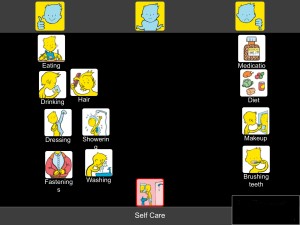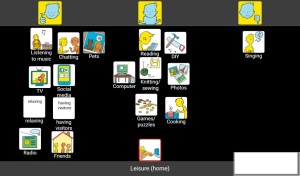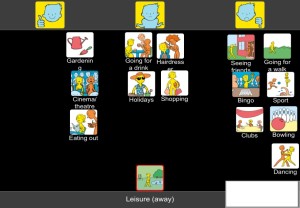Thanks to the Action Group in Edinburgh for their great blog about their co-trainer Lynnette Linton .
In 2016, a number of people with learning disabilities attended a Talking Mats training designed to build their communication skills and confidence so they could use to interview others about their community participation, in regard to Charter for Involvement goals. One of those trained was Lynnette Linton, the National Involvement Network Chairperson, and a Service User of The Action Group in Edinburgh.
Lynnette interviewed several fellow service users using Talking Mats, and was supporting in the role of ‘Listener’ by Liz Taylor, an Action Group Training Officer, who as a consequence of this work requested to become an Accredited TM Trainer. The Charter highlights that support organisations should involve Service Users in training their staff, so it then seemed natural for Liz and Lynnette to deliver TM training to Action Group staff together, with Lynnette in the role of volunteer co-trainer.
Lynnette has since been a core part of training over 50 employees (including those at Senior levels) in Foundation Talking Mats training with the Keeping Safe add-on. Liz says, it helps that Lynnette is “naturally gifted at speaking to people, and ably demonstrates the significance of TM as a means of having your say on the service you wish to receive”.
Lynnette and Liz do a demonstration Mat together, and then when trainees are doing their own Mat or showing their videos, Lynnette points out where they are applying the key TM principles (Lynnette enjoys issuing certificates to those who successfully complete the course). She also shares anonymised stories from her experience of interviewing ‘Thinkers’, which help get across what Action Group Users “want to change and improve about their service”.
Liz says, “Our first experience of demonstrating a Mat together didn’t quite go to plan, as Lynnette became unexpectedly upset when discussing her views of a football team, when she was reminded of a close friend who had died who had been a fan”. As difficult as this was for both Lynnette and Liz at the time, it was a powerful example of how TM helps us express emotions we may not even have been ourselves aware are ‘under the surface’, and sparked real interest in TM as a communicative tool.
The Action Group started gathering feedback specifically for Lynnette in her role as co-trainer, as part of the training evaluation and trainees have said that “she is exceptionally welcoming and puts everyone at ease; her passion for the topic is very evident, and it is very beneficial to hear real life examples, and how TM helps in her own life”. This includes how Lynnette benefits from the Keeping Safe pack, as a means of raising more ‘difficult’ issues.
Lynnette says, “As a service user, I also now see myself as an important, valued co-trainer. [Training] is something I see myself doing more of in the future. My confidence has shot right up. It makes me feel proud, and my parents get to hear about it at my Review”.
Staff also see the real importance of acting on the actions from each person’s Mat. Lynnette acknowledges that co-delivering has sometimes “been difficult, because I know some of the people we’re training. But I’ve been able to speak up about what I want from my support, my environment.” Recently she trained her own Service Development Manager and Team Manager, and although she felt it was harder to be honest, she had a captive audience, and her Managers then followed through on actions from her demonstration mats: “It’s made a difference to me, after doing a Mat with my DM about my home. I put ‘safety’ in the ‘Thumbs Down’, because I get frightened, and now I’ve got a security chain and a peephole on the door”.
“I never thought I would be training the staff. Now we’re booked up!”
Click for information about the Accredited training and or the Keeping Safe resource mentioned in the blog
Huge thanks to all the practitioners who have sent us guest blogs. We selected our 10 favourite guest blogs…in no particular order!
- Talking Mats to support children who stammer Kirsten Taylor, Speech and Language Therapist tells a moving story about how finding out what was upsetting a boy with a stammer helped to implement change.
- Hearing the voice of the child Emma Atkiss, Senior Educational Psychologist, shares her findings from the Wigan Pathfinder project reporting that using a Talking Mat helps to meet the 5 criteria of Shier’s model of participation.
- Talking Mats for capacity assessments in people with ASD/LD Ruth Spilman, Senior SLT from The Cambian Group, shares practical tips on assessing capacity.
- Castle hill school supports pupil voice Jenna McCammon, SLT and Rebecca Highton, SLT Assistant, tell 3 inspiring stories using TMs in: selective mutism; safeguarding and motivational interviewing.
- Supporting Looked After Children to have their say Karen Wilson, Principal Teacher for children with additional support needs in a mainstream secondary school shares her experience of using TMs to give young people a stronger voice in making decisions affecting them.
- Hearing the voices of Looked After Children Rachel Clemow, Head Teacher and Donna Wood, Education Support Worker, report that Talking Mats has enabled children to express their thoughts and views in a safe, neutral environment.
- Talking Mats and Mental Health Carla Innes, Clinical Psychologist for learning disability from Healthy Young minds Stockport talks about the impact of TM training on the whole team.
- Mummy I don’t want to go to nursery today read about how using a Talking Mat might shed some light on why a 4 year old was upset at the thought of going to nursery.
- How do you feel about starting school? The story of 4 year old twins and their thoughts about starting school.
- Sibling Attitudes Prof Juan Bornman from Pretoria in South Africa publishes a report on a study carried out with 27 typically developing children who have a younger sibling with a severe speech and language disability.
If you have been inspired and are not yet trained to use Talking Mats – come along to one of our training courses.
The Talking Mats Keeping Safe Learning Disability projects ends but a resource that promotes safeguarding and well-being continues.
The Keeping Safe Talking Mat provides a structured framework to ask someone ’How’s your life going? We are grateful to the Scottish Government Keys to Life monies for funding the trials. Impact of use of the resource was gained by practitioners sending in examples of their use of Keeping Safe, and the outcomes and actions from the Mats were themed.
The resource has been shown as a helpful way to
- discuss new information (89%). Staff frequently commented that using the Mats revealed things they had not known previously.
- discuss and resolve fears (84%) . It provided a framework that was supportive for those more difficult and or sensitive conversations e.g.’ Usually when she expresses her feelings she can get either upset or angry. She did not get upset or angry at any point through doing the Talking Mats, although the subject and things she was saying was at times difficult issues.’
- support thinking (89%) ‘It helps with memory and attention as she has something visual to keep her focused.’
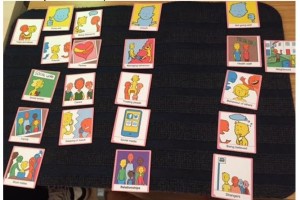
Initially many staff thought using the resource would take too much time but in fact were really surprised to find how much quality information they got in a short space of time. A cost benefit analysis demonstrated that using the Keeping Safe resource is cost effective for organisations i.e. for every £1.00 an organisation spends on the training and the resource, the potential financial benefit to the organisation is £23.00. We believe this is because the Mats create a powerful listening space and so that issues can be addressed timeously and not spiral out of control. This has not only a financial benefit but also a return in terms of an individual’s well-being and access to local non specialist services.
Although this resource was developed with adults with a learning disability, several people have reported that they have found it useful with other client groups e.g. adults with acquired neurological disorders and young people particularly with mental health issues .
If you want to read in more detail about the design process behind the resource then please read this journal article published in the Tizard Learning Disability Review More Than Pictures TLDR 2017
Involving people with a learning disability in service evaluation is both essential and challenging.
Maria Lavery speech and language therapist, and her colleagues in North and South Lanarkshire are using Talking Mats to get feedback about the service they deliver for people with a learning disability . They want to find out about what people feel they do well, and what could be done differently. In addition they have placed a suggestion box at the entrance to their building, but want to involve everyone who is connected with their service – clients, family, carers various multi-agency colleagues and are carrying the review out over a 6 month period.
The analysis and learning will be used to inform the Speech & Language Therapy work plan and support the future direction of the service.
Talking Mats has been used successfully to evaluate Augmentative and Alternative Communication services and the resource for this is available on our website http://www.talkingmats.com/wp-content/uploads/2013/09/AAC-service-Evaluation-script-and-symbols.pdf
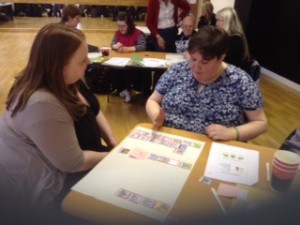
Talking Mats and the National Involvement Network (NIN) have been working together for the past year to enable the NIN members to develop a Talking Mat and to use that Mat to listen to the experiences of people with learning disabilities . It has been a great project and we wrote up the experience of running the training in two earlier blogs.
The first blog described how we worked with the group to develop a Talking Mat to link with the NIN’s charter for involvement . The second how we developed and delivered a Talking Mats training course to meet the needs of the NIN members all of whom have learning disabilities
The group then set off to carry out their Talking Mats conversations supported by staff from their respective organisations and or ARC Scotland. The group decided they wanted to make a film about their experiences of using Talking Mats and ARC Scotland supported them to do this . Rhona and I were delighted when we got this link to the film all about their experiences of using Talking Mats. We really enjoyed watching it and we are sure you will to. https://www.youtube.com/watch?v=0BTlYuqLBXs
Five short stories from our recent accredited training course in Stirling.
- A looked after child was unhappy but no one knew specifically why. Using the Talking Mats, she indicated that she was upset by the weekly phone call with her mother because it always happened when it was her playing time. The time of the call was moved to just before her bedtime but this resulted in bad dreams. The time of the call was finally moved to Saturday afternoon which helped her settle and reduced her distress.
- Talking Mats was used with an Iraqi boy who had come to England via Libya, Italy and the jungle camp at Calais. When he picked the symbol of a waiting room he indicated that despite all she had been through he really liked this because it reminded him of all the children in his family and made him happy.
- A 76-year-old man with a learning disability disclosed that he had been attacked and suffocated by his upstairs neighbour one week previously. It was only when he used the Talking Mats that he disclosed to anyone what had happened.
- A lecturer usually used quantifying measuring with her students to find out how they were managing their studies. Instead she used Talking Mats to find out how they were coping with their work life balance. One student told her that she was managing fine except that her pet rabbits always escape under the bed and it takes her a long time to get them back out so she does not let them out very often!
- Talking Mats was used with a man who had had a stroke and had to go into residential care because his family could no longer look after him. They were very worried that he was unhappy with the new care set up. He was able to show with the Talking Mats that he was happy about everything except that he was not given enough time when he went to the toilet. Once the staff realised this they then gave him more time which resolved the situation and reassured his family.
Please send us your Talking Mats stories – we love hearing them.
We’re always amazed to hear from people about the variety of topics they cover using Talking Mats –from how someone is managing their self care or domestic tasks, to arranging a wedding, or thinking about whats important at a funeral.
As a communication tool Talking Mats maximises a person’s capacity to reflect on a topic and express their view. It gives confidence in decision making.
Here are some other topics we’ve heard about recently.
- As a conversation tool in class
- Pupil voice in school improvement plan
- Client contribution to meetings and review day placement
- Respite
- Operations e.g. gastrostomy
- Health
- Postural management
- Where to live
- Childs opinions in relation to GIRFEC
- Respite feedback/choices
- SW assessments
- Choices available within service
- Going somewhere new
- Transitions
- Problem solving ie horse riding, identifying the problem
- Eating and Drinking
- Keeping Safe
- Social Media
What do you want to talk about? There is no limit!
We are now half way through our project, funded by The Health and Social Care ALLIANCE Scotland, whose overall aim is to empower people with a range of long term conditions, with and without additional communication difficulties, to self-manage their own health and well-being by using Digital Talking Mats.
Participants
We have carried out all the initial visits and 16 follow-up visits and participants are sending in their completed mats, choosing whichever topics they want from the digital Health and Well-being resource. At the time of writing this blog we have received 137 completed mats.
We have received very positive feedback with many examples of how people are using the Digital Talking Mats to self-manage.
Here are 3 examples:
One participant with learning disability has diabetes. Through using the Digital Talking Mats she has stopped buying takeaways every night and is now buying M&S ‘Balanced for You’ meals. This is a huge step forward for her as she refused to discuss healthier eating before.
A man with early onset dementia has identified that he used to enjoy singing and has decided for the first time in his life to join a choir. This is not something that had come up in conversation before. Despite the diagnosis of dementia he has realised that he is still keen to try new things.
The wife of a man with severe aphasia said ‘This (Leisure away) has highlighted how few things he can do away from home. We discussed this but can’t see how we can change the situation.’ However at the second visit he used the same mat and indicated that he had been thinking about his mobility and was about to start swimming and a fitness class.
We already have an increased awareness of the meaning of self-management as we observe how participants are using the Digital Talking Mats to think about their situation, state their own views and share them with carers/support workers. We are also noticing that there is a shift in some relationships as the carers/support workers realise that the person with the long term conditions can make decisions and express their own views rather than having decisions made for them.
The Keeping Safe Talking Mat resource provides a structured framework to ask someone ’How’s your life going? It has 3 topics: Your Well-being; Relationships; Thoughts and Feelings
Do you find it difficult discussing feelings with people who have limited understanding?
Do you have limited time to discuss sensitive issues with people?
Do you want to find out any issues which may be slowing recovery or preventing someone moving forward in life?
A cost benefit analysis demonstrated that using the Keeping Safe resource to create a listening space for people to think and share how their lives are going, is cost effective for organisations.
The design of the resource is described in the Tizard Learning Disability Review More Than Pictures TLDR 2017
It has been trialled and tested with people with learning disabilities throughout Scotland, but has also been used effectively with a range of people who find it difficult to discuss their life e.g. Young people with mental health condition.
It has been shown as a helpful way to
- discuss new information (89%),
- discuss and resolve fears (84%)
- support thinking (89%)
This poster gives an overview of the project KS 2nd Poster (click to enlarge)
The Thoughts and Feelings topic uses a different top scale and this resource is best used by people who have completed Talking Mats Foundation Training. If you want to buy it (£55.00 +VAT) contact the office www.talkingmats.com tel. (+44) 01786 479511
Health professionals from Stockport have shared how using Talking Mats has positively impacted on their clinical work.
Laura, our North West Associate, met up with Carla Innes, Clinical Psychologist for learning disability from Healthy Young minds Stockport (a child and adolescent mental health service provided by Pennine Care NHS Foundation Trust) and Clare Royle, Family Support Worker,from the Children’s Learning Disability Team (provided by Stockport NHS Foundation Trust). The two organisations work closely together to provide joined up care to young people with a learning disability.
Six months ago Carla, Clare and seven others from the Healthy Young Minds Stockport Team received training to enable them to introduce Talking Mats as part of their challenging behaviour pathway.
Carla and Claire said that the staff team are very positive about the impact of Talking Mats. The overall impression is that Talking Mats has enabled staff to gain an individualised sense of the child or young person they are working with, as well as empowering the children and young people to share their views and opinions. Carla also notes that using Talking Mats has helped her to focus on the child/young person’s abilities/potential – their ‘zone of proximal development’ – and to ensure that everyone is working within that.
Some of the other positive features of using Talking Mats include:
– Providing ‘headspace’ for the child/young person to process their thoughts and to really consider what is important to them.
– Giving a holistic, child/YP centred account and narrative of their feelings and behaviour.
– Helping to inform and direct clinical decision making e.g. introduction of an approach such as CBT.
– Enabling children/young people who have previously refused, or been very reluctant, to share their views and opinions about topics which have been troubling them for example, school attendance and issues with sleep.
– Providing of a communication framework which is neutral and non-threatening – much less intense than direct verbal questioning or conversation.
– Helping to make abstract concepts more concrete for the listener to understand.
– Being a safe, flexible and quick method of finding practical solutions and determining direct actions.
– Enabling the listener to gain a better understanding of the thinker’s level of knowledge and understanding about a particular topic such as healthy eating. This can help inform capacity assessments e.g. in terms of medical consent or the use of medication. The mental capacity act states that appropriate support should be given to young people to make informed decisions and to communicate those decisions.
In addition, from a wider team perspective, Carla and Clare report that they have all noticed benefits in terms of consistency of Talking Mats use by all members of the multi-disciplinary team. Each team member using the Talking Mats tool is working from a slightly different perspective; using Talking Mats ensures that the child/young person is kept at the centre of the process. This results in a truly holistic view of the child/young person’s feelings, views and opinions.
 Online training login
Online training login 


